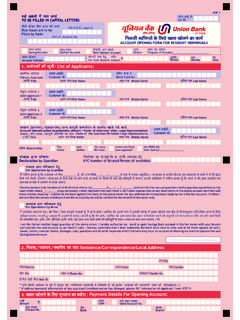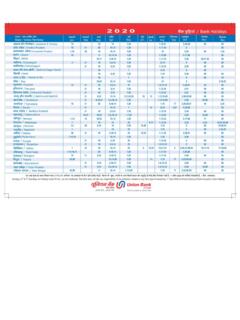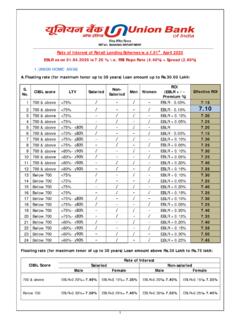Transcription of CHAPTER 33 MERCHANTING TRADE - unionbankofindia.co.in
1 1 CHAPTER 33 MERCHANTING TRADE 2 CHAPTER 33 MERCHANTING TRADE INDEX Para No TOPIC Page No 33 Definition 3 33 1 Conditions for Classification as MERCHANTING TRADE 3 33 2 Permitted Goods 3 33 3 Routing of Transactions 4 33 4 Time Frame for Completion / Outlay of Funds 4 33 5 Commencement / Completion date 4 33 6 Short Term Credits / LC 4 33 7 1 Advance Payment for Export Leg 4 33 7 2 Advance Payment for Import Leg 5 33 8 AD bank s Responsibility / Reporting 5 Add No 1 Addendum Revised bank Guidelines 6 Annex No Annexure 1 Statement in default in MERCHANTING TRADE ( Sep attached) 3 33. DEFINITION In Indian Context, the TRADE is called MERCHANTING TRADE when, The supplier of goods will be resident in one foreign country The buyer of goods will be resident in another foreign country The merchant or the intermediary will be resident in India In simple terms, MERCHANTING transaction is one which involves shipment of goods from one foreign country to another foreign country involving an Indian Intermediary.
2 Hence, It is also called Intermediary TRADE . Conditions for Classification as MERCHANTING TRADE For a TRADE to be classified as MERCHANTING TRADE following conditions should be satisfied ; Goods acquired should not enter the Domestic Tariff Area of the Importing Country and The state of the goods should not undergo any transformation and meant for transport from country of supplier to the country of the buyer. Permitted Goods Goods involved in the MERCHANTING TRADE transactions would be the ones that are permitted for exports / imports under the prevailing Foreign TRADE Policy (FTP) of India, as on the date of shipment and all the rules, regulations and directions applicable to exports (except Export Declaration Form) and imports (except Bill of Entry), are complied with for the export leg and import leg respectively AD bank should be satisfied with the bonafides of the transactions.
3 Further, KYC and AML guidelines should be observed by the AD bank while handling such transactions 4 Routing of Transactions Both the legs of a MERCHANTING TRADE transaction are to be routed through the same AD bank . The bank should verify the documents like invoice, packing list, transport documents and insurance documents (if originals are not available, Non-negotiable copies duly authenticated by the bank handling documents may be taken) and satisfy itself about the genuineness of the TRADE Time Frame for Completion / Outlay of Funds The entire MERCHANTING TRADE transactions (both import and export) should be completed within an overall period of nine months and there should not be any outlay of foreign exchange beyond four months. Commencement / Completion date The commencement of MERCHANTING TRADE would be the date of shipment / export leg receipt or import leg payment, whichever is first.
4 The completion date would be the date of shipment / export leg receipt or import leg payment, whichever is the last Short Term Credits / LC Short-term credit either by way of suppliers' credit or buyers' credit will be available for MERCHANTING TRADE transactions, to the extent not backed by advance remittance for the export leg, including the discounting of export leg LC by an AD bank , as in the case of import transactions. It should be ensured that the funds are utilized for MERCHANTING TRADE only. Advance Payment for Export Leg In case advance against the export leg is received by the MERCHANTING trader, AD bank should ensure that the same is earmarked for making payment for the respective import leg. However, AD bank may allow short- 5 term deployment of such funds for the intervening period in an interest bearing account Advance Payment for Import Leg MERCHANTING traders may be allowed to make advance payment for the import leg on demand made by the overseas seller.
5 In case where inward remittance from the overseas buyer is not received before the outward remittance to the overseas supplier, AD bank may handle such transactions by providing facility based on commercial judgement. It may, however, be ensured that any such advance payment for the import leg beyond USD 200,000/- per transaction, the same should be paid against bank guarantee / LC from an international bank of repute except in cases and to the extent where payment for export leg has been received in advance Letter of credit to the supplier is permitted against confirmed export order keeping in view the outlay and completion of the transaction within nine months Payment for import leg may also be allowed to be made out of the balances in Exchange Earners Foreign Currency Account (EEFC)
6 Of the merchant trader AD bank s Responsibility / Reporting AD bank should ensure one-to-one matching in case of each MERCHANTING TRADE transaction and report defaults in any leg by the traders to the concerned Regional Office of RBI, on half yearly basis in the format as annexed, within 15 days from the close of each half year, June and December. The names of the defaulting MERCHANTING traders, whose outstanding reach 5% of their annual export earnings would be caution listed by RBI. The MERCHANTING traders have to be genuine traders of goods and not mere financial intermediaries. Confirmed orders have to be received by them from the 6 overseas buyers. AD banks should satisfy themselves about the capabilities of the MERCHANTING trader to perform the obligations under the order. The overall MERCHANTING TRADE should result in reasonable profits to the MERCHANTING trader Reporting for MERCHANTING TRADE transactions for compilation of R-return should be done on gross basis, against the undernoted codes: TRADE Purpose Code under FETERS Description Export P0108 Goods sold under MERCHANTING /receipt against export leg of MERCHANTING TRADE Import S0108 Goods acquired under MERCHANTING /payment against import leg of MERCHANTING TRADE Addendum Our bank s Revised Guidelines : It may be observed from the conditions for classification of MERCHANTING TRADE by RBI, as in para above, that the condition of the goods in the MERCHANTING TRADE do not enter in DTA in case of import and not leave the country in case of export, whereas outflow and inflow of foreign exchange takes place in/out of the country.
7 In view of the above, it is necessary that utmost caution is exercised by branches while handling such transactions. In view of the revised RBI guidelines further rationalizing the MERCHANTING TRADE transactions, branches shall adhere to the following guidelines in addition to the RBI guidelines as follows : i. KYC / AML guidelines Branches shall undertake MERCHANTING transactions on behalf of fully KYC compliant customers with good track record of three years and above. Branches to ensure bonafides of the MERCHANTING transactions as well as KYC and AML checks on both the suppliers and the buyers of the goods. For the purpose of complying with the KYC and AML guidelines, the branches shall ensure the following : a) Obtain Credit Report both on the seller and the buyer from the approved Credit Information Agencies. The credit information report should be satisfactory. 7 b) Check from UBINET (useful links others) that the seller and the buyer are not in any sanction list of the US, UNSC, SDN or any other sanction list imposed by any other country / organization.
8 C) The branches shall also visit World Check site also to verify the status of the seller / buyer of the goods to ascertain that their names are not appearing in any negative list. d) The branch should satisfy itself from sources like Shipping Time , etc. about the movement of the goods as stated in the Bill of Lading submitted. ii. Goods permitted for MERCHANTING TRADE : Goods involved in MERCHANTING TRADE transactions would be the ones that are Freely Permitted for exports / imports under the prevailing Foreign TRADE Policy of India, as on the date of shipment and all the rules, regulations and directions applicable to export (except Export Declaration Form) and imports (except Bill of Entry), are complied with for the export leg and import leg respectively. iii. Verification of documents : a) Branches shall verify the documents like invoice, packing list, transport documents and insurance documents (if originals are not available, Non-negotiable copies duly authenticated by the bank handling documents may be taken) and satisfy itself about the genuiness of the TRADE .
9 B) Both the legs of the MERCHANTING TRADE transactions to be routed through the same B Category branch. iv. Time limit for settlement of MERCHANTING TRADE : a) The commencement of MERCHANTING TRADE would be the date of shipment / export leg receipt or import leg payment, whichever is first. The completion date would be the date of shipment / export leg receipt or import leg payment, whichever is the last. 8 b) The entire MERCHANTING TRADE transactions should be completed with an overall period of nine months and there should be any outlay of foreign exchange beyond four months including Buyers / Suppliers Credit or Discount of Export LC. v. Availability of TRADE Credit & Discount of Export LC : Short-term credit either by way of buyers credit or suppliers credit will be available for the MERCHANTING TRADE transactions, to the extent not backed by advance remittance for the export and as per extant guidelines of Short Term Credit, subject to the following : a) Import LC is in place.
10 B) Corresponding Export LC from the reputed Banks as per guidelines on Prime Banks (Instructions Circular ) is in place. c) Appropriate credit approval for buyers credit / suppliers credit against MERCHANTING TRADE is in place. The period of Buyer s Credit shall not exceed four months as the outlay of foreign currency shall not exceed four months as stated in para (b) above. vi. Discounting of Export LC : a) Discounting of Export LC from reputed Banks as per guidelines on Prime Banks, is permitted. The interest rate for discounting of Export LC under MERCHANTING TRADE Transactions should be charged at rates applicable to ECNOS (Export Credit Not Otherwise Specified). Branches to ensure that there should not be double financing (by way of Buyers Credit and by way of Bill Discounting) for the same transaction. Period of discounting of export LC should not exceed four months as the outlay of foreign exchange shall not exceed four months as per (b) above.












